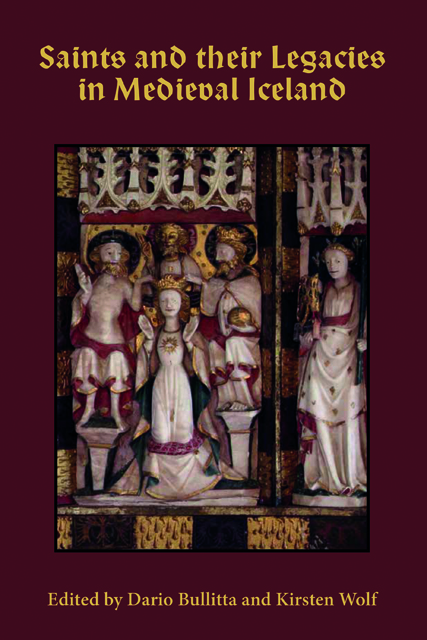Book contents
- Frontmatter
- Contents
- List of Illustrations
- List of Contributors
- Acknowledgments
- List of Abbreviations
- Introduction: The Splendor of the Saints
- Rannsǫkun Heilagra Bóka: The Search for Holy Books
- Heilagir Byskupar: Holy Bishops
- Heilagir Karlar ok Englar: Holy Men and Angels
- Heilagar Meyjar: Holy Maidens
- Bibliography
- Index of Manuscripts
- General Index
- Studies in Old Norse Literature
12 - St Agnes of Rome in Late Medieval and Early Modern Icelandic Verse
Published online by Cambridge University Press: 14 January 2023
- Frontmatter
- Contents
- List of Illustrations
- List of Contributors
- Acknowledgments
- List of Abbreviations
- Introduction: The Splendor of the Saints
- Rannsǫkun Heilagra Bóka: The Search for Holy Books
- Heilagir Byskupar: Holy Bishops
- Heilagir Karlar ok Englar: Holy Men and Angels
- Heilagar Meyjar: Holy Maidens
- Bibliography
- Index of Manuscripts
- General Index
- Studies in Old Norse Literature
Summary
St Agnes, the young Christian virgin who was martyred in Rome in the fourth century, was a highly important early virgin martyr saint. Her story, the oldest attested rendering of which is in Ambrose of Milan’s (c. 340–397) De virginibus from 377, enjoyed widespread popularity in Latin and the vernacular and in both ecclesiastical and popular tradition. The most influential legend of St Agnes and the one on which all subsequent versions are based in one way or another is the so-called Passio Agnetis or Gesta sanctae Agnetis (BHL 156), which has been attributed to Ambrose but was written by an anonymous author now referred to as Pseudo-Ambrose. According to the Pseudo-Ambrosian legend, Agnes was born to a noble Roman Christian family. One day, the prefect Symphronius’ son caught sight of Agnes as she was walking home from school and immediately fell in love with her. He attempted to get her hand in marriage but was promptly rejected and returned home heartbroken. Symphronius demanded that Agnes change her mind, and ultimately, he gave her two choices: either sacrifice to idols and become a Vestal Virgin or live her life as a prostitute. She refused both, and as a result she was led naked to a brothel. Her hair miraculously grew to cover her body, and when she entered the brothel, an angel appeared, cast a bright light around her for protection, and gave her a garment with which to cover her body. This miraculous trifecta of events transformed the brothel into a place of prayer, so that everyone who entered was purified. This angered Symphronius’ son, who, followed by his companions, stormed the building. He attempted to rape Agnes, but was immediately struck dead. The heartbroken Symphronius demanded that Agnes resurrect his son, and after she had successfully brought him back to life, both father and son converted to Christianity. The temple priests, however, continued to press their case against Agnes, who was charged with witchcraft. Symphronius dared not oppose the priests, so he recused himself from the trial and had his lieutenant, Aspasius, continue the proceedings. Aspasius requested that Agnes be burned. She was thrown into the flames, but they did not harm her and were extinguished through her prayers. Finally, Aspasius himself thrust a sword into Agnes’ throat, at which point she died as a martyr with her virginity intact.
- Type
- Chapter
- Information
- Saints and their Legacies in Medieval Iceland , pp. 307 - 324Publisher: Boydell & BrewerPrint publication year: 2021



